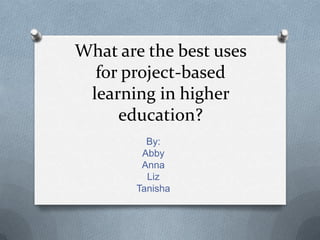
Ed 335 pbl
- 1. What are the best uses for project-based learning in higher education? By: Abby Anna Liz Tanisha
- 2. Problem-Based Learning O Problem-based learning (PBL) is an educational approach that challenges students to "learn to learn.” O Students work cooperatively in groups to seek solutions to real-world problems and more importantly, to develop skills to become self-directed learners.
- 3. Project-Based Learning O Based on constructivist theory O Purposing O Planning O Executing O Judging O MAIN GOAL: Engage your learners
- 4. Quote O Kilpatrick stated, “engaging learners in purposeful activities that they help to select, plan, implement, and evaluate facilitates learners’ learning and helps them solve problems and acquire the skills and judgment necessary to function as adults in a democratic society” (Foshay, 1999).
- 5. Project-Based Learning O Has to be used to rebuild real-world complexity O Collaborative learning promotes the exchange and reflection on different views. O Uses: O Team work skills, O alternative perspectives on a problem O central skill for performing tasks
- 6. Adult Learners O Adult education is defined as “participation in systematic learning activities for the purpose of acquiring new knowledge or skills or changing attitudes or values, by persons who have assumed adult social roles” (Lyman, 1999, p. 102).
- 7. Common Characteristics • They are in a continuing process of growth, not at the start of a process. • They bring with them a package of experience and values. • They come to education with intentions. • They bring expectations about the learning process. • They have competing interests. • They already have their own set of patterns of learning (p. 24).
- 8. Self-Directed O Student takes charge of own learning, with minimal help from the instructor. O Using: Computer based learning.
- 9. Goal-Oriented O Student come into the learning experience knowing the goal they want to achieve. O Teacher has set up class so students can reach their goal.
- 10. Relevancy-Oriented O Learning has to be applicable to the student’s work or other responsibilities to be of value to them. O Instructor then identifies objectives for adult participants before the course begins.
- 11. Bloom's Taxonomy
- 12. Cont. O “Benjamin Bloom created this taxonomy for categorizing level of abstraction of questions that commonly occur in educational settings. The taxonomy provides a useful structure in which to categorize test questions, since professors will characteristically ask questions within particular levels, and if you can determine the levels of questions that will appear on your exams, you will be able to study using appropriate strategies.”
- 13. LEARNING TO LEARN O COOPERATIVE LEARNING SKILLS O INQUIRY SKILLS O REFLECTION SKILLS O ASSESSMENT O CONCLUSION
- 14. Some challenges for PBL classrooms O Limited experience in group work management O Lack of familiarity with inquiry learning O Inadequate feedback on learning and assessment
- 15. Limited experience in group work management O Group work is integral to PBL and students need to learn how to make optimal use of their time and resources while working in groups. Functioning effectively in groups involves knowing how to organize the work, distribute responsibility, break up complex tasks, and provide useful feedback on work that is done. Teachers can contribute by helping students better understand the merits of group work.
- 16. Lack of familiarity with inquiry learning O When faced with problem tasks, students often find it difficult to identify the critical issues and to generate coherent research designs. They are often unclear about how they can relate what they are currently reading to what they already know. They are also unfamiliar with different stages of the inquiry process, such as generating hypotheses, providing logical arguments, and transforming data into a product. When students have an appropriate learning context and the need to seek the necessary information, they also see how things finally "come together". This is an aspect of critical reading that can be promoted within the framework of problem-based learning.
- 17. Inadequate feedback on learning and assessment O Giving feedback to students is integral to improving student learning. Barron et al. (1998) suggest that teachers can better guide and monitor projects by incorporating formative self-reflections by students, by creating a classroom culture that supports frequent feedback and assessment, and by finding ways for students to compare their work with others. Teachers can make students take their work seriously by incorporating opportunities that involve external audiences in assessing students' performance.